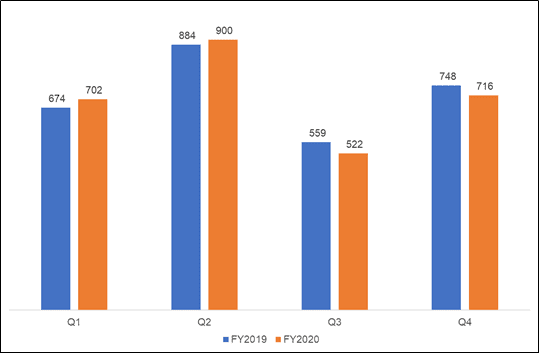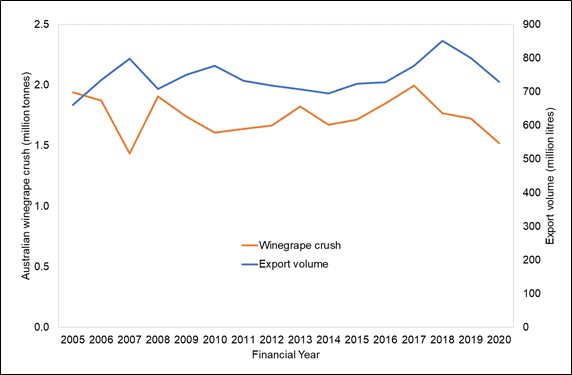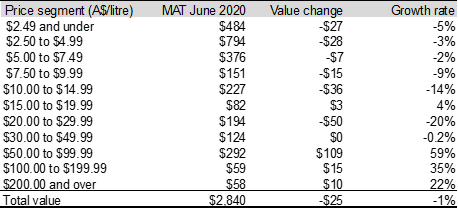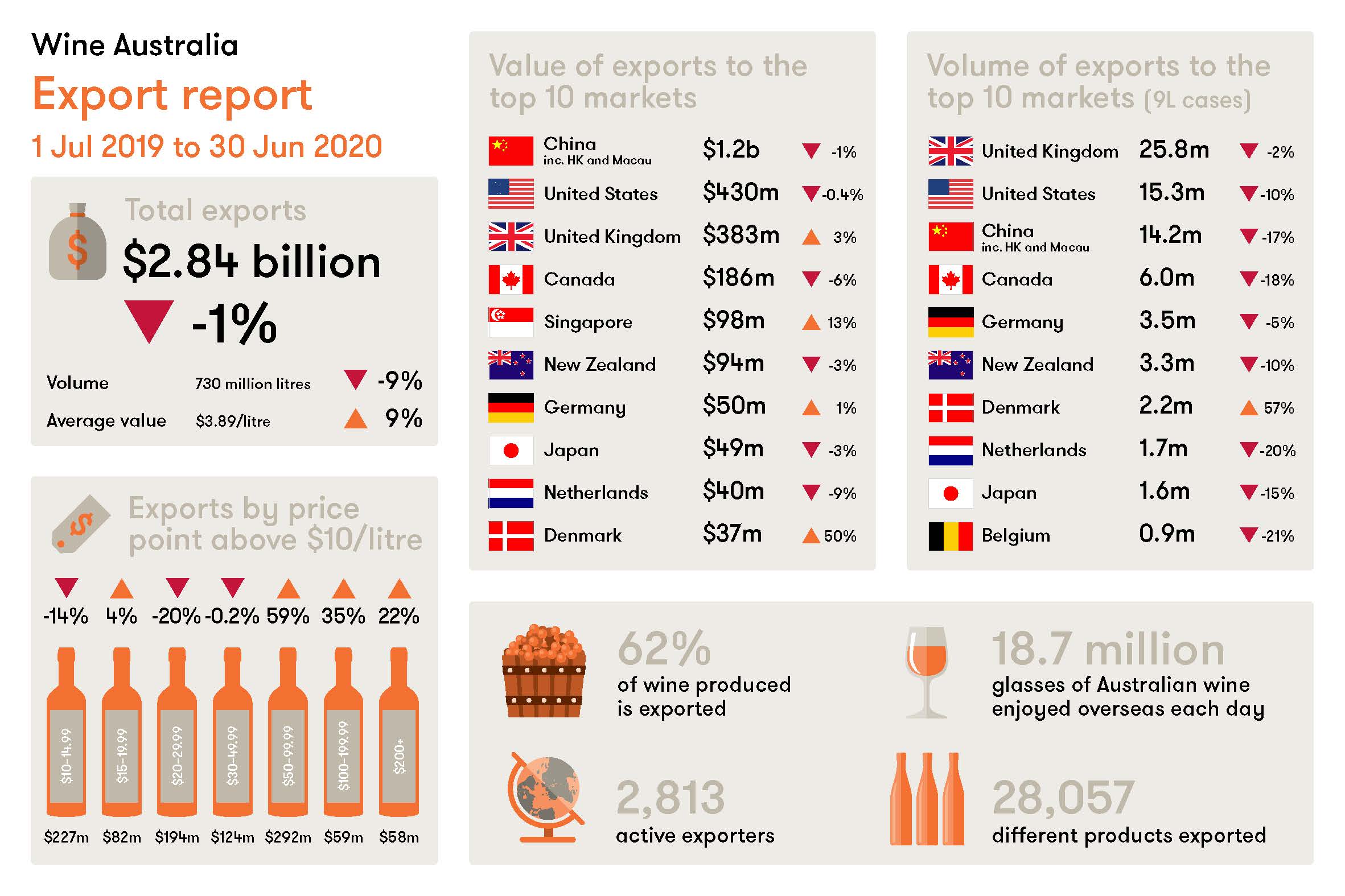
The total value of Australian wine exports decreased by one percent to $2.84 billion in 2019-20. The average value of exports grew to $3.89 per litre free on board (FOB) – the highest level since 2004-05.
The overall volume of Australian wine exports fell nine percent to 730 million litres.
With all eyes on China, exports to mainland China increased by 0.7 percent in value to $1.1 billion and decreased by 17 percent in volume to 121 million litres.
Wine Australia CEO Andreas Clark said exports during the first two quarters of the year were following the growth trajectory of previous years but, as illustrated in Figure 1, they fell in the latter two quarters as the restrictions hit economies worldwide.
“The advent of the Covid-19 pandemic has resulted in unprecedented disruption to wine markets around the world with the closure of restaurants, cafes and bars,” Mr Clark said.
“While the first two quarters of 2019-20 showed increases in exports, in the third quarter ending March 2020, exports declined seven percent in value on the comparable quarter in the previous year, while the fourth quarter was slightly stronger with a decline in exports of four percent in value.”
Mr Clark said there remained considerable uncertainty surrounding the extent, duration and impact of the Covid-19 pandemic in health and economic terms. However, there were some clear trends emerging in key markets in relation to wine sales.
“Overall, demand for wine and wine consumption has held up in most markets around the world,” he said.
“The biggest impact has been on how consumers have purchased wine, with the shutdown of the on-premise channel [cafés, restaurants and hotels] and a shift to purchasing more wine online. In the off-trade channel [retail liquor sales], there has been growth across all price points, with the trend to premium and fine wine continuing however, the trend for declining commercial/value sales has reversed, with people gravitating to known brands and everyday rather than occasion wines.”

Figure 1. Value of exports by quarter (million AUD) – FY2019 v FY2020.
The growth in average value was driven by declines in export volumes, which decreased by nine percent to 730 million litres (81 million 9-litre case equivalents), the decline led by wine exports in the lower price segments. The decline in volume is the result of less wine being available for export given the lower vintages of 2018, 2019 and 2020 as illustrated in Figure 2.
Mr Clark said that, as the 2020 vintage was the smallest Australia had experienced in a decade, the decline in export volumes was principally driven by supply shortage rather than softening demand.

Figure 2. Australian winegrape crush v export volume over time.
Packaged and unpackaged wine
Glass bottle exports declined by 0.4 percent in value to $2.3 billion and decreased by eight percent in volume to 325 million litres (36 million 9-litre case equivalents). This translated to an eight percent increase in the average value of bottled exports to $7.08 per litre FOB. This rise in average value is due to an increase in exports at the high end of the price spectrum (see price point section below).
Unpackaged wine exports decreased by three percent in value to $518 million and 10 per cent in volume to 397 million litres (44 million 9-litre case equivalents).
Due to the volume decline outpacing value decline, the average value of unpackaged wine exports increased by eight percent to $1.31 per litre FOB. The average value of unpackaged exports has remained high and is at levels not seen since late 2005 due to the relative short supply of Australian wine in an already constrained global supply situation.
Price segments
In 2019-20, all price segments below $15 per litre FOB declined in value (see Figure 3). This decline was partially offset by strong growth in exports at $50 or more per litre FOB.
Overall, exports $10 per litre FOB and above grew by five percent to $1.04 billion.

Figure 3. Exports by price segment (millions AUD FOB).
Destinations
In the past year, Australian exporters shipped wine to 116 destinations. Exports increased in value to Europe (by three percent to $615 million) and South East Asia (by 0.3 percent to $181 million).
The value shipped to Europe was the highest since 2011-12, while shipments to South East Asia represent a financial-year record. The United Kingdom, Germany and Scandinavia drove growth to Europe, while Singapore and Indonesia were the key drivers behind the growth to South East Asia.
The top five destinations by value were:
- Mainland China, up 0.7 per cent to $1.1 billion,
- United States of America (USA), down 0.4 percent to $430 million,
- United Kingdom, up three percent to $383 million,
- Canada, down six percent to $186 million, and
- Singapore, up 13 percent to $98 million.
Mainland China
Exports to mainland China increased by 0.7 percent in value to $1.1 billion and decreased by 17 percent in volume to 121 million litres (13 million 9-litre case equivalents). Average value increased by 22 percent to $9.07 per litre FOB.
The growth in the average value was due to ongoing growth in exports at higher price points as well as a decline at the low-end. Exports at $10 or more per litre FOB increased by 11 percent to $670 million, while those at less than $5 per litre FOB declined by 18 per cent to $211 million.
Despite the recent decline in value, Australia remains the number one imported wine category in mainland China and has performed better than its key competitors in the last year. Import data from the Global Trade Atlas shows that Australia held a 37 percent share of the value of wine imported by mainland China in the 12 months ended May 2020, well ahead of France on 27 percent, Chile with 13 percent and Italy with six percent. While Australian exports increased, French imports fell by 36 percent, Chile by 26 percent and Italy by 12 percent.
United States of America
In 2019-20, the value of exports to the United States of America declined by 0.4 percent to $430 million and volume declined by 10 percent to 137 million litres (15 million 9-litre case equivalents). The average value increased by 11 percent to $3.13 per litre FOB.
Covid-19 and restrictions on hospitality venues and the growth in retail sales appear to have assisted Australian wine sales with the value of exports stabilising in the third quarter before increasing by 14 percent in the fourth quarter.
United Kingdom
In 2019-20, Australian wine exports to the UK increased by three percent in value to $383 million, despite a two percent reduction in volume to 232 million litres (26 million 9-litre case equivalents). Average value increased by five percent to $1.65 per litre FOB.
There was growth at both low and higher price points.
Photo by Rubén Bagüés on Unsplash














Recent Comments